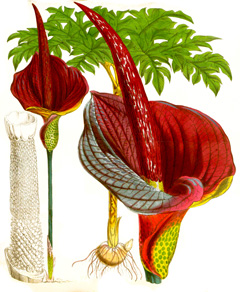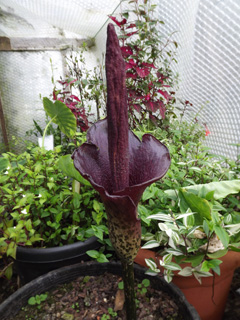 |
|
https://edibleplants.org/ |
 |
| https://commons.wikimedia.org/wiki/User:UrbanJungle |
Translate this page:
Summary
Devil's tongue or Amorphophallus konjac is a perennial plant with a bipinnate single leaf growing from a corm. The leaf grows up to 100 cm long while the corm grows up to 30 cm in diameter. The plant is widely cultivated in Japan and China as food source. The corm is edible but contains calcium oxalate that makes it toxic if consumed raw, so it must be cooked thoroughly or fully dried. In Japan, the corm is known as a great source of Konnyaku, a type of flour used in many dietary products, and jelly. Flowers are used as treatment for fever. The root is used in facilitating childbirth, as a sialogogue (increases the saliva flow rate), and as treatment for cancer. The corm contains glucomannan which helps in weight loss, relieving constipation and irritable bowel syndrome, and reducing serum cholesterol levels. The plant also has insecticidal properties.
Physical Characteristics

 Amorphophallus konjac is an evergreen Perennial growing to 1.3 m (4ft 3in) by 1.3 m (4ft 3in) at a fast rate.
Amorphophallus konjac is an evergreen Perennial growing to 1.3 m (4ft 3in) by 1.3 m (4ft 3in) at a fast rate.
See above for USDA hardiness. It is hardy to UK zone 8 and is frost tender. The flowers are pollinated by Flies.
Suitable for: light (sandy) and medium (loamy) soils and prefers well-drained soil. Suitable pH: mildly acid, neutral and basic (mildly alkaline) soils and can grow in very acid soils.
It can grow in full shade (deep woodland) or semi-shade (light woodland). It prefers moist soil.
UK Hardiness Map
US Hardiness Map
Synonyms
Amorphophallus mairei H.L?v. Amorphophallus nanus H.Li & C.L.Long Amorphophallus palmiformis Durieu
Plant Habitats
Edible Uses
Edible Parts: Root
Edible Uses:
Corm - cooked[ 200 ]. The root must be thoroughly boiled or baked, it is acrid when raw (see notes above on 'Known Hazards'[ K ])[ 200 ]. Very large, it can be up to 30cm in diameter[ 266 ]. In Japan the large brown tubers are peeled, cooked and pounded to extract their starch, which is solidified with dissolved limestone into an edible gel called 'Konnyaku'[ 183 ]. Konnyaku is a type of flour valued for its use in many dietary products[ 266 ]. The flour is valued for its ability to clean the digestive tract without being a laxative[ 183 ]. A nutritional analysis is available[ 218 ]. This root is very high in water and low in calories, so it is being promoted as a diet food in N. America[ 218 ]. Especially just before the foliage declines prior to dormancy, the tubers are a rich source of mannan, a polysaccharide of mannose and glucose[ 472 ]. The mannose is extracted and widely used in foods for diabetics[ 472 ]. Glucomannan, a soluble fibre formed from mannan and glucose, cannot be metabolized by the human body, but is metabolized by intestinal bacteria. Inside the digestive system, glucomannan absorbs up to 200 times its weight in water without any negative action upon the digestive system. It therefore can give a feeling of fullness and be of use to aid in weight loss, it also relieves constipation and irritable bowel syndrome, as well as reducing serum cholesterol levels[ 472 ]. Glucomannan is widely used as an emulsifier and stabilizer in foods and drinks[ 472 ].
References More on Edible Uses
Medicinal Uses
Plants For A Future can not take any responsibility for any adverse effects from the use of plants. Always seek advice from a professional before using a plant medicinally.
The root is oxytocic and sialagogue[ 178 ]. It is used in the treatment of cancer[ 218 ]. Glucomannan, a soluble fibre obtained from the tuber, cannot be metabolized by the human body, but is metabolized by intestinal bacteria. Inside the digestive system, glucomannan absorbs up to 200 times its weight in water without any negative action upon the digestive system. It therefore can give a feeling of fullness and be of use to aid in weight loss, it also relieves constipation and irritable bowel syndrome, as well as reducing serum cholesterol levels[ 472 ]. The flowers are febrifuge[ 218 ].
References More on Medicinal Uses
The Bookshop: Edible Plant Books
Our Latest books on Perennial Plants For Food Forests and Permaculture Gardens in paperback or digital formats.

Edible Tropical Plants
Food Forest Plants for Hotter Conditions: 250+ Plants For Tropical Food Forests & Permaculture Gardens.
More

Edible Temperate Plants
Plants for Your Food Forest: 500 Plants for Temperate Food Forests & Permaculture Gardens.
More

More Books
PFAF have eight books available in paperback and digital formats. Browse the shop for more information.
Shop Now
Other Uses
Other uses rating: Low (2/5). Agroforestry Uses: A system of cultivation, known as jinjenjo, is often practised in Japan. In this, the plants are grown in a natural plant community and heavily mulching the plants with grain straw or wild herbs. The plants thus grown are remarkably free from pests and diseases. The largest tubers are harvested at the end of the year, leaving the rest in the ground to grow on for harvest in later years[ 472 ]. Other Uses The plant has insecticidal properties[ 218 ]. Glucomannan, obtained from the tuber, has a wide range of used in various industries. It has gelling and film-forming properties and is widely used as an emulsifier and stabilizer in foods, drinks, cosmetics and the pharmaceutical industry. It is also used as a non-clay drilling fluid in the diamond and oil industries[ 472 ]. Ground cover.
Special Uses
Food Forest
References More on Other Uses
Cultivation details
Plants can tolerate a minimum temperature of 15c during the growing season, though the optimum range is 20 - 25c[ 472 ]. The best crops are produced on deep, fertile, alluvial soils that are slightly acid[ 300 ]. Dislikes heavy clay soils[ 300 ]. Plants require some shade, especially when young[ 300 ]. Members of this genus generally require a moist but well-drained, humus-rich, fertile soil and a position in dappled shade[ 472 ]. The plant produces one enormous leaf and one flowering stem annually. When ripe for pollination, the flowers have a foetid smell to attract carrion flies and midges. This smell disappears once the flower has been pollinated[ 245 ]. The tubers are planted 15cm deep[ 1 ]. Like many species in the family Araceae, this plant has the ability to heat the flowering spadix as the pollen becomes ready for fertilization. This heat greatly increases the strength of the aroma released by the plant, thus attracting more pollinating insects. It can also have the effect of making the insects more active, thus increasing the level of fertilization[ 472 ]. The plant is heat tolerant in zones 12 through 10. (Plant Hardiness Zones show how well plants withstand cold winter temperatures.
Plant Heat Zones show when plants would start suffering from the heat.
The Plant Heat Zone map is based on the number of "heat days" experienced in a given area where the temperature climbs to over 86 degrees F (30°C).
At this temperature, many plants begin to suffer physiological damage. Heat Zones range from 1 (no heat days) to 12 (210 or more heat days).
For example Heat Zone. 11-1 indicates that the plant is heat tolerant in zones 11 through 1.) For polyculture design as well as the above-ground architecture (form - tree, shrub etc. and size shown above) information on the habit and root pattern is also useful and given here if available. The plant growth habit is a clumper with limited spread [1-2]. The root pattern is a corm swelling at the stem base [1-2].
References Carbon Farming Information and Carbon Sequestration Information
Temperature Converter
Type a value in the Celsius field to convert the value to Fahrenheit:
Fahrenheit:
The PFAF Bookshop
Plants For A Future have a number of books available in paperback and digital form. Book titles include Edible Plants, Edible Perennials, Edible Trees,Edible Shrubs, Woodland Gardening, and Temperate Food Forest Plants. Our new book is Food Forest Plants For Hotter Conditions (Tropical and Sub-Tropical).
Shop Now
Plant Propagation
Seed - best sown in a pot in a warm greenhouse as soon as it is ripe and the pot sealed in a plastic bag to retain moisture. It usually germinates in 1 - 8 months at 24c[ 133 ]. When large enough to handle, prick the seedlings out into individual pots and grow them on in the greenhouse for at least a couple of years. Plant them out in late spring or early summer, after the last expected frosts, and give them some protection such as a cloche until they are growing away strongly. Division of offsets[ 1 ]. These are rarely produced[ 1 ].
Other Names
If available other names are mentioned here
Devil's Tongue, Devil's Tongue, Snake Plant, Konjac, Konnyaku Potato, Voodoo Lily
Native Range
TEMPERATE ASIA: Yunnan Sheng, China. TROPICAL ASIA: Vietnam,
Weed Potential
Right plant wrong place. We are currently updating this section.
Please note that a plant may be invasive in one area but may not in your area so it's worth checking.
None Known
Conservation Status
IUCN Red List of Threatened Plants Status : This taxon has not yet been assessed.

Growth: S = slow M = medium F = fast. Soil: L = light (sandy) M = medium H = heavy (clay). pH: A = acid N = neutral B = basic (alkaline). Shade: F = full shade S = semi-shade N = no shade. Moisture: D = dry M = Moist We = wet Wa = water.
Now available:
Food Forest Plants for Mediterranean Conditions
350+ Perennial Plants For Mediterranean and Drier Food Forests and Permaculture Gardens.
[Paperback and eBook]
This is the third in Plants For A Future's series of plant guides for food forests tailored to
specific climate zones. Following volumes on temperate and tropical ecosystems, this book focuses
on species suited to Mediterranean conditions—regions with hot, dry summers and cool, wet winters,
often facing the added challenge of climate change.
Read More
Expert comment
Author
K.Koch
Botanical References
1
Links / References
For a list of references used on this page please go here
A special thanks to Ken Fern for some of the information used on this page.
Readers comment
| Add a comment |
|
If you have important information about this plant that may help other users please add a comment or link below. Only comments or links that are felt to be directly relevant to a plant will be included. If you think a comment/link or information contained on this page is inaccurate or misleading we would welcome your feedback at [email protected]. If you have questions about a plant please use the Forum on this website as we do not have the resources to answer questions ourselves.
* Please note: the comments by website users are not necessarily those held by PFAF and may give misleading or inaccurate information.
To leave a comment please Register or login here All comments need to be approved so will not appear immediately.
|
Subject : Amorphophallus konjac
|
|
|
|